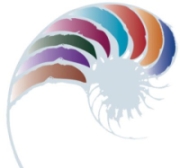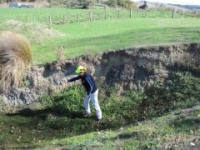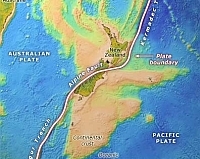<- Homepage: Natural Hazards: Our Taupō supervolcano

All LEARNZ field trips targeting primary and secondary schools are closely linked to the New Zealand curriculum, in particular science, social studies and geography. They can also be used by other subject teachers.
Key concepts
Bay of Plenty, citizenship, earth processes, earth science, earthquake research, earthquakes, eruptions, extreme natural events, fossils, future focus, geohazards, geothermal energy, hazards, hydrothermal activity, lahars, landforms, landscapes, landslides, lava, mountains, Ngāuruhoe, planning for volcanic events, plate tectonics, rock types, Ruapehu, science, scientific research, seismic monitoring, Taupō, tectonic plates, Tongariro, tsunami, volcanoes, volcanology.
The New Zealand Curriculum - NZC
Key Competencies
LEARNZ virtual field trips contribute to the development of all five key competencies:
| Key Competencies | Examples of Related Field Trip Components |
| Thinking | Constructing questions to put to experts during Web conferences. |
| Using language, symbols and texts | Interpreting and making meaning of a variety of language and symbols in the Background Pages and throughout the web site. |
| Managing self | Numerous content-related Activities provide students with chances to engage with the material and create their own interpretation of the content. |
| Relating to others | Videos connect students with a range of expert opinions. |
| Participating and contributing | LEARNZ Virtual Field Trips are an ideal medium for group-based topic inquiry. They also enable students to transfer new learning into the context of their own communities where they are encouraged to take action. |
(See page 12-13 NZC 2007)
Values
The Natural Hazards field trip encourages, models and explores these values:
- innovation, inquiry and curiosity
- ecological sustainability
- community and participation
(see page 10 NZC 2007).
E-learning and pedagogy
The Natural Hazards field trip directly involves learning that is supported by information and communication technology (ICT).
In particular, the trip will:
- Assist the making of connections by enabling students to enter and explore new learning environments, overcoming barriers of distance and time.
- Facilitate shared learning by enabling students to join or create communities of learners that extend well beyond the classroom.
- Enhance opportunities to learn by offering students virtual experiences and tools that save them time, allowing them to take their learning further (Page 36 NZC 2007).
Social Science
| Strand | Achievement Aims |
|
Social Studies
|
Continuity and Change
Place and Environment
Identity, Culture, and Organisation
Economic World
|
Science
| Strand | Achievement Aims |
|
The Nature of Science
|
Participating and contributing
Understanding about science
Communicating in science
|
|
Planet Earth and Beyond
|
Earth systems
|
The five science capabilities
| Science Capability | Description |
|
|
Learners make careful observations and differentiate between observation and inference. Science knowledge is based on data derived from direct, or indirect, observations of the natural physical world and often includes measuring something. An inference is a conclusion you draw from observations – the meaning you make from observations. Understanding the difference is an important step towards being scientifically literate. |
|
|
Learners support their ideas with evidence and look for evidence supporting others' explanations. Science is a way of explaining the world. Science is empirical and measurable. This means that in science, explanations need to be supported by evidence that is based on, or derived from, observations of the natural world. |
|
|
Not all questions can be answered by science. In order to evaluate the trustworthiness of data, students need to know quite a lot about the qualities of scientific tests. |
|
|
Scientists represent their ideas in a variety of ways, including models, graphs, charts, diagrams and written texts. Learners think about how data is presented and ask questions such as:
|
|
|
This capability requires students to use the other capabilities to engage with science in “real life” contexts. It involves students taking an interest in science issues, participating in discussions about science and at times taking action. |
Technology
| Strand | Achievement Aims |
|
Nature of Technology
|
Nature of Technology
|
Mathematics
| Strand | Achievement Aims | Related Activities |
|
Number and Algebra
|
Level 3: Use a range of additive and simple multiplicative strategies with whole numbers, fractions, decimals, and percentages Level 4: Use a range of multiplicative strategies when operating on whole numbers Level 4: Generalise properties of multiplication and division with whole numbers |
|
English
The selected processes and strategies indicators used in the table below are from Level three of the NZC, but aim to cover indicators from levels two to four.
| Strand | Processes and Strategies Indicators | Example of Related Field Trip Component |
|
Speaking, Writing and Presenting
|
|
|
|
Listening, Reading and Viewing
|
|
|
NCEA
Science
- Science 1.3: Demonstrate understanding of the formation of surface features in New Zealand. See the NCEA Internal Assessment Resource AS90952 "Let's Look at Our Local Area" - PDF (292k)
- Science 1.16: Investigate an astronomical or Earth science event. See the NCEA Internal Assessment Resource AS90955 "When Christchurch Shook" - PDF(210k).
- ESS 2.3: Investigate geological processes in a New Zealand locality. See the NCEA Internal Assessment Resource AS91189 "Taupō Volcanic Zone" - PDF (242k)
- ESS 2.5: Demonstrate understanding of the causes of extreme Earth events in New Zealand
- ESS 2.7: Demonstrate understanding of physical principals related to the Earth System
- ESS 3.3: Demonstrate understanding of the evidence relating to geological events
Geography
Level 1
- 1.1 Demonstrate geographic understanding of environments that have been shaped by extreme natural event(s) (AS91007) - earthquake, tsunami or landslide.
- 1.6 Describe aspects of a contemporary New Zealand geographic issue (AS91012) - planning for a geohazard, hazard assessment, impacts, risk mitigation.
- 1.8 Apply spatial analysis, with direction, to solve a geographic problem. See the NCEA Internal Assessment Resource AS91014 "Ruaumoko Erupts" - PDF (327k) - co-ordinating a response to a natural disaster.
Level 2
- 2.1 Demonstrate geographic understanding of a large natural environment (AS91240) - fault line features, volcanic landscapes
- 2.6 Explain aspects of a contemporary New Zealand geographic issue (AS91245) - planning for a geohazard, hazard assessment, impacts, risk mitigation.
Level 3
- 3.1 Analyse natural processes in the context of a geographic environment (AS90701) - landslides, seismology, predicting earthquakes, frequency and magnitude earthquakes, fault lines.
- 3.6 Analyse a contemporary geographic issue and evaluate courses of action (AS90706) - planning for a geohazard, hazard assessment, impacts, risk mitigation.










